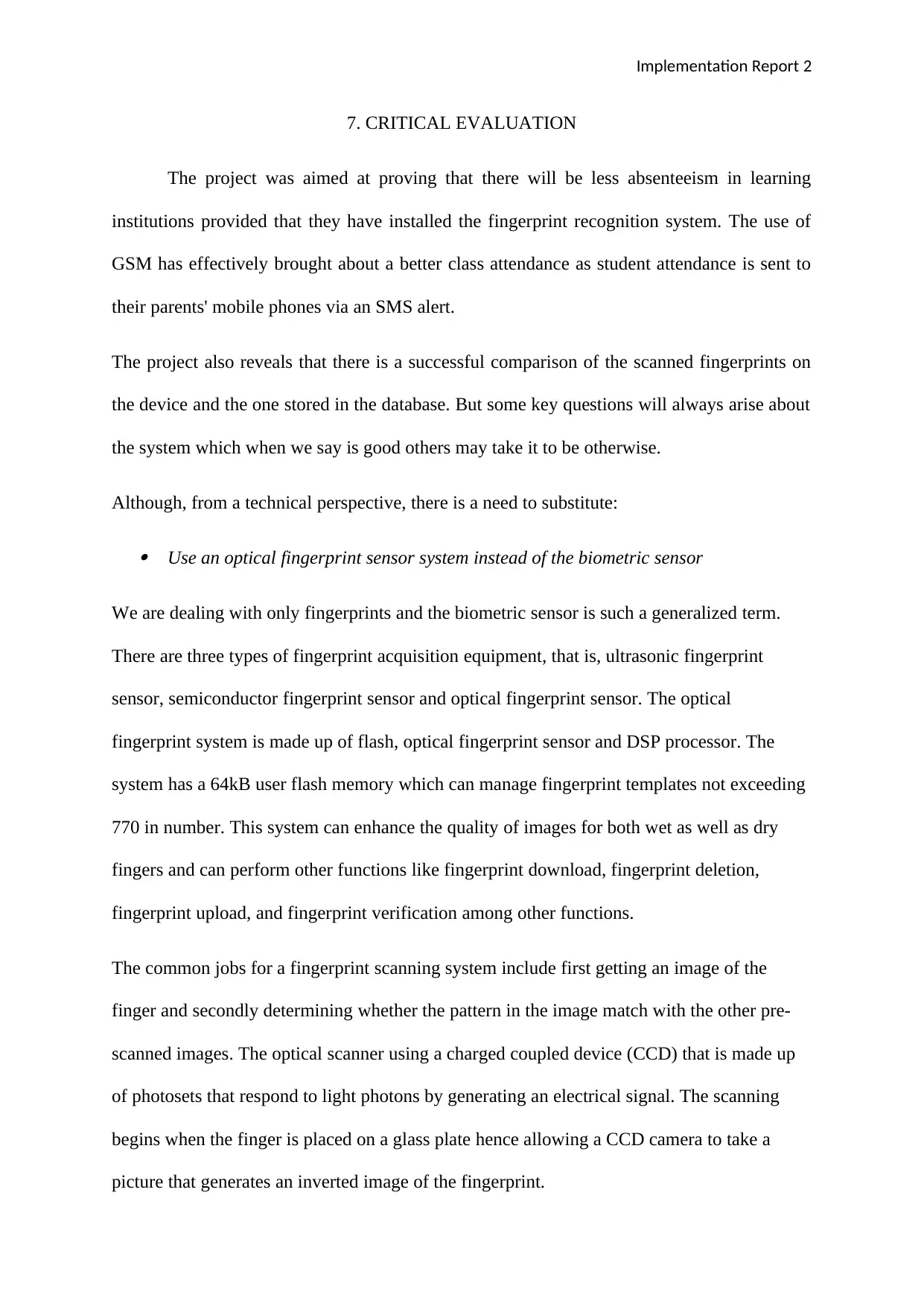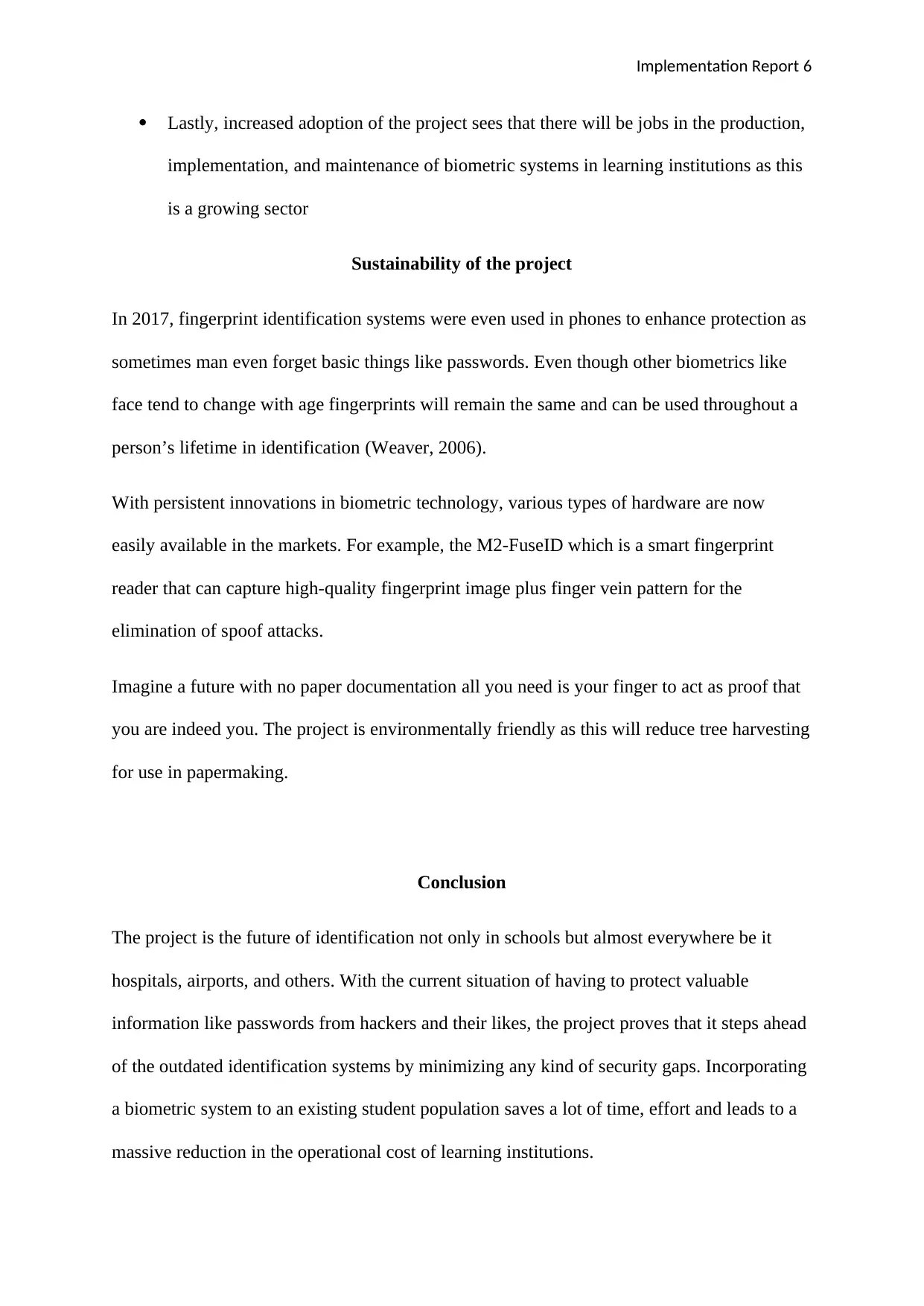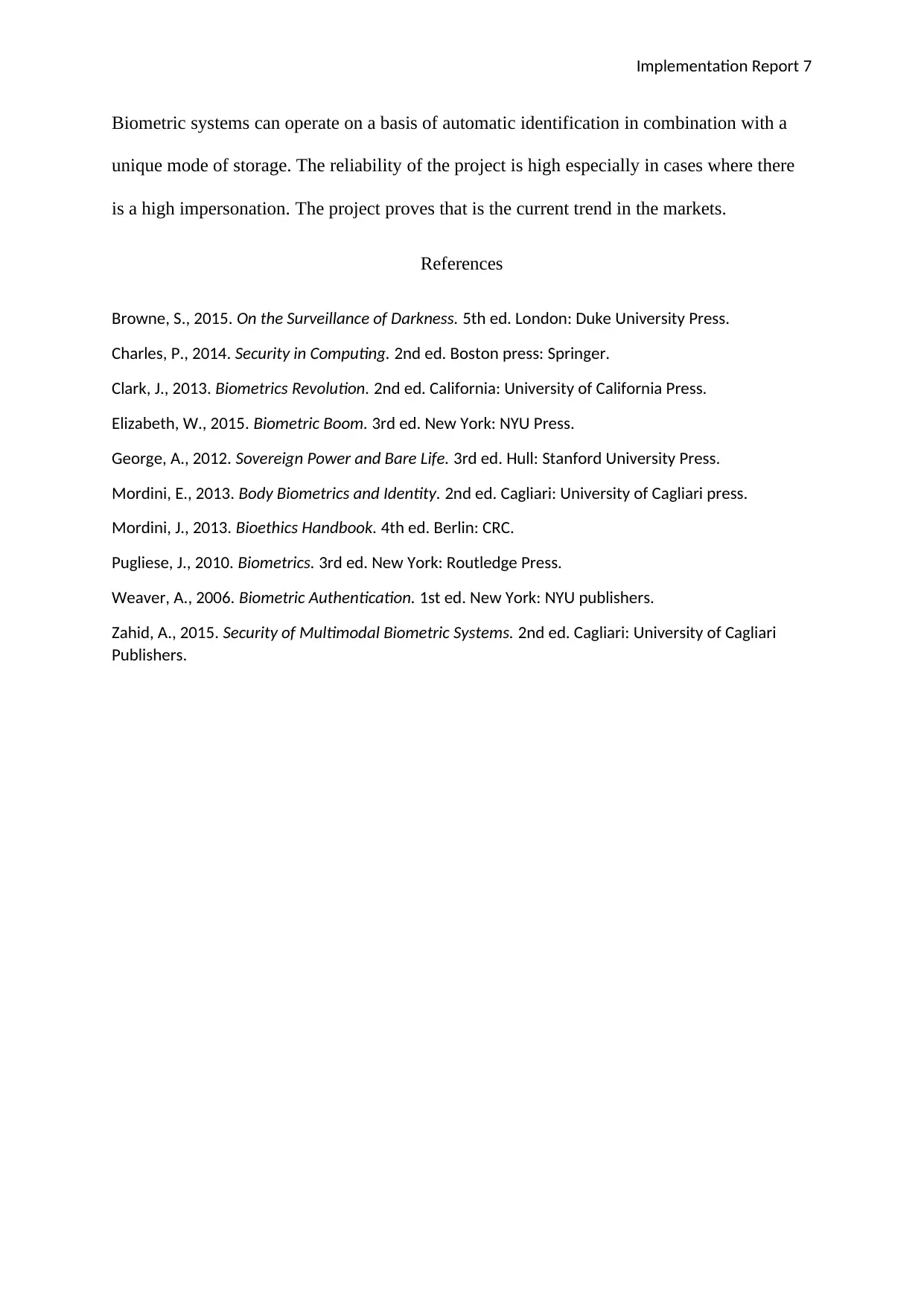Analysis and Implementation Report: Fingerprint Recognition Project
VerifiedAdded on 2021/10/28
|7
|1532
|245
Report
AI Summary
This implementation report examines a fingerprint recognition system designed to reduce absenteeism in learning institutions. The project utilizes GSM for parent notifications and compares scanned fingerprints against a database. The report evaluates the system's technical aspects, including the use of an optical fingerprint sensor, the P89V51RD2 microcontroller, and potential hardware and software frameworks. It addresses legal, social, ethical, and sustainability considerations, such as data protection, socio-economic impacts, and the environmental benefits of reduced paper usage. The report concludes that the project represents the future of identification, offering enhanced security, time-saving benefits, and cost reductions for educational institutions. References to relevant literature are also included.

Implementation Report 1
IMPLEMENTATION REPORT
By Name
Course
Instructor
Institution
Location
Date
IMPLEMENTATION REPORT
By Name
Course
Instructor
Institution
Location
Date
Paraphrase This Document
Need a fresh take? Get an instant paraphrase of this document with our AI Paraphraser

Implementation Report 2
7. CRITICAL EVALUATION
The project was aimed at proving that there will be less absenteeism in learning
institutions provided that they have installed the fingerprint recognition system. The use of
GSM has effectively brought about a better class attendance as student attendance is sent to
their parents' mobile phones via an SMS alert.
The project also reveals that there is a successful comparison of the scanned fingerprints on
the device and the one stored in the database. But some key questions will always arise about
the system which when we say is good others may take it to be otherwise.
Although, from a technical perspective, there is a need to substitute:
Use an optical fingerprint sensor system instead of the biometric sensor
We are dealing with only fingerprints and the biometric sensor is such a generalized term.
There are three types of fingerprint acquisition equipment, that is, ultrasonic fingerprint
sensor, semiconductor fingerprint sensor and optical fingerprint sensor. The optical
fingerprint system is made up of flash, optical fingerprint sensor and DSP processor. The
system has a 64kB user flash memory which can manage fingerprint templates not exceeding
770 in number. This system can enhance the quality of images for both wet as well as dry
fingers and can perform other functions like fingerprint download, fingerprint deletion,
fingerprint upload, and fingerprint verification among other functions.
The common jobs for a fingerprint scanning system include first getting an image of the
finger and secondly determining whether the pattern in the image match with the other pre-
scanned images. The optical scanner using a charged coupled device (CCD) that is made up
of photosets that respond to light photons by generating an electrical signal. The scanning
begins when the finger is placed on a glass plate hence allowing a CCD camera to take a
picture that generates an inverted image of the fingerprint.
7. CRITICAL EVALUATION
The project was aimed at proving that there will be less absenteeism in learning
institutions provided that they have installed the fingerprint recognition system. The use of
GSM has effectively brought about a better class attendance as student attendance is sent to
their parents' mobile phones via an SMS alert.
The project also reveals that there is a successful comparison of the scanned fingerprints on
the device and the one stored in the database. But some key questions will always arise about
the system which when we say is good others may take it to be otherwise.
Although, from a technical perspective, there is a need to substitute:
Use an optical fingerprint sensor system instead of the biometric sensor
We are dealing with only fingerprints and the biometric sensor is such a generalized term.
There are three types of fingerprint acquisition equipment, that is, ultrasonic fingerprint
sensor, semiconductor fingerprint sensor and optical fingerprint sensor. The optical
fingerprint system is made up of flash, optical fingerprint sensor and DSP processor. The
system has a 64kB user flash memory which can manage fingerprint templates not exceeding
770 in number. This system can enhance the quality of images for both wet as well as dry
fingers and can perform other functions like fingerprint download, fingerprint deletion,
fingerprint upload, and fingerprint verification among other functions.
The common jobs for a fingerprint scanning system include first getting an image of the
finger and secondly determining whether the pattern in the image match with the other pre-
scanned images. The optical scanner using a charged coupled device (CCD) that is made up
of photosets that respond to light photons by generating an electrical signal. The scanning
begins when the finger is placed on a glass plate hence allowing a CCD camera to take a
picture that generates an inverted image of the fingerprint.

Implementation Report 3
Use the P89V51RD2 microcontroller
This is line with specifications of optical fingerprint system for best output of the system. It
has 1024 bytes of data RAM plus 64kB flash and is usually In-Application Programmable
(IAP) that allows the reconfiguration of the flash program memory on running application.
The microcontroller runs the following functions:
1. Powering up and initializing the dependent modules.
2. Checking for interruptions and errors while the modules are initializing.
3. Commanding the fingerprint module to work in harmony with the software
interface.
4. Enabling data transmission through a wireless network.
Project problems
1. Selecting of the hardware and software framework to be used to achieve desired
results.
2. Keeping automation test cases up to date as daily there are more and more
development cycles as setting the software and hardware doesn’t mean that they will
work.
Use the P89V51RD2 microcontroller
This is line with specifications of optical fingerprint system for best output of the system. It
has 1024 bytes of data RAM plus 64kB flash and is usually In-Application Programmable
(IAP) that allows the reconfiguration of the flash program memory on running application.
The microcontroller runs the following functions:
1. Powering up and initializing the dependent modules.
2. Checking for interruptions and errors while the modules are initializing.
3. Commanding the fingerprint module to work in harmony with the software
interface.
4. Enabling data transmission through a wireless network.
Project problems
1. Selecting of the hardware and software framework to be used to achieve desired
results.
2. Keeping automation test cases up to date as daily there are more and more
development cycles as setting the software and hardware doesn’t mean that they will
work.
⊘ This is a preview!⊘
Do you want full access?
Subscribe today to unlock all pages.

Trusted by 1+ million students worldwide

Implementation Report 4
8. LEGAL, SOCIAL, ETHICAL, AND SUSTAINABILITY ASPECT TO THE RELATED
PROJECT
Legal and Ethical Issues
For any project to run smoothly, the ethical code of conduct in running the system must be
put first to avoid events like law suits. The project is supposed to check class attendance in
general by ensuring the physical representation of the student in the actual learning institution
grounds. But some ethical and legal aspects may present themselves as follows:
Data protection of individual is key as this in line with the fundamental Human Rights
of the Data Protection Act that states “data shall be adequate, relevant and not
excessive in relation to the purpose or purposes which they were collected or are
further processed.” The term “excessive” is to be put into consideration and requires
case by case analysis of the school environment, system reliability, efficiency and
purpose.
There shall be fair obtaining and processing of the data that shall be guided by given
consent by students and also parents and the legitimate interests of the school
(Charles, 2014).
Also, there shall be transparency to the parents and students in issues like the purpose
of processing student data using the fingerprint system, identity of the data controller
in the school and any third party who might have access to the biometric data.
Socio-Economic issues
On a negative note:
8. LEGAL, SOCIAL, ETHICAL, AND SUSTAINABILITY ASPECT TO THE RELATED
PROJECT
Legal and Ethical Issues
For any project to run smoothly, the ethical code of conduct in running the system must be
put first to avoid events like law suits. The project is supposed to check class attendance in
general by ensuring the physical representation of the student in the actual learning institution
grounds. But some ethical and legal aspects may present themselves as follows:
Data protection of individual is key as this in line with the fundamental Human Rights
of the Data Protection Act that states “data shall be adequate, relevant and not
excessive in relation to the purpose or purposes which they were collected or are
further processed.” The term “excessive” is to be put into consideration and requires
case by case analysis of the school environment, system reliability, efficiency and
purpose.
There shall be fair obtaining and processing of the data that shall be guided by given
consent by students and also parents and the legitimate interests of the school
(Charles, 2014).
Also, there shall be transparency to the parents and students in issues like the purpose
of processing student data using the fingerprint system, identity of the data controller
in the school and any third party who might have access to the biometric data.
Socio-Economic issues
On a negative note:
Paraphrase This Document
Need a fresh take? Get an instant paraphrase of this document with our AI Paraphraser

Implementation Report 5
Biometrics can blur previously clear boundaries that exist between social processes
and human skills that bestows rights and duties, technological abilities of the
fingerprint system and control access to social space (Mordini, 2013). In this case, the
assumption means that biometrics are clever even then the teachers as it can
differentiate the present and absent students.
How often will the kit be cleaned? And if so is there a guarantee that diseases cannot
be spread by placing your fingers on the finger system? In reality, the sensors where
people touch can lead to a disease outbreak if not well cleaned.
Social issues usually pose a big threat to any project but what is bad can also be good as
explained below:
To begin with, there are many cases of students signing in for other students or even
worse some do semester exams for others without getting caught. But with the
fingerprint system, a student will have to be there in person thereby reducing
malpractices like exam cheating.
Furthermore, with the project comes additional security and safety of students. Every
parent wants their kids to safe especially in a school or college as the inward and
outward movement of people shall be limited hence creating a much-protected
environment.
Biometrics leads to time-saving considering the number of students whom if it were
to be physically identified would take too much time.
Also, day to day paper documentation of class attendance is expensive considering
you have to buy stationary coupled with the additional costs of printing identification
cards.
Biometrics can blur previously clear boundaries that exist between social processes
and human skills that bestows rights and duties, technological abilities of the
fingerprint system and control access to social space (Mordini, 2013). In this case, the
assumption means that biometrics are clever even then the teachers as it can
differentiate the present and absent students.
How often will the kit be cleaned? And if so is there a guarantee that diseases cannot
be spread by placing your fingers on the finger system? In reality, the sensors where
people touch can lead to a disease outbreak if not well cleaned.
Social issues usually pose a big threat to any project but what is bad can also be good as
explained below:
To begin with, there are many cases of students signing in for other students or even
worse some do semester exams for others without getting caught. But with the
fingerprint system, a student will have to be there in person thereby reducing
malpractices like exam cheating.
Furthermore, with the project comes additional security and safety of students. Every
parent wants their kids to safe especially in a school or college as the inward and
outward movement of people shall be limited hence creating a much-protected
environment.
Biometrics leads to time-saving considering the number of students whom if it were
to be physically identified would take too much time.
Also, day to day paper documentation of class attendance is expensive considering
you have to buy stationary coupled with the additional costs of printing identification
cards.

Implementation Report 6
Lastly, increased adoption of the project sees that there will be jobs in the production,
implementation, and maintenance of biometric systems in learning institutions as this
is a growing sector
Sustainability of the project
In 2017, fingerprint identification systems were even used in phones to enhance protection as
sometimes man even forget basic things like passwords. Even though other biometrics like
face tend to change with age fingerprints will remain the same and can be used throughout a
person’s lifetime in identification (Weaver, 2006).
With persistent innovations in biometric technology, various types of hardware are now
easily available in the markets. For example, the M2-FuseID which is a smart fingerprint
reader that can capture high-quality fingerprint image plus finger vein pattern for the
elimination of spoof attacks.
Imagine a future with no paper documentation all you need is your finger to act as proof that
you are indeed you. The project is environmentally friendly as this will reduce tree harvesting
for use in papermaking.
Conclusion
The project is the future of identification not only in schools but almost everywhere be it
hospitals, airports, and others. With the current situation of having to protect valuable
information like passwords from hackers and their likes, the project proves that it steps ahead
of the outdated identification systems by minimizing any kind of security gaps. Incorporating
a biometric system to an existing student population saves a lot of time, effort and leads to a
massive reduction in the operational cost of learning institutions.
Lastly, increased adoption of the project sees that there will be jobs in the production,
implementation, and maintenance of biometric systems in learning institutions as this
is a growing sector
Sustainability of the project
In 2017, fingerprint identification systems were even used in phones to enhance protection as
sometimes man even forget basic things like passwords. Even though other biometrics like
face tend to change with age fingerprints will remain the same and can be used throughout a
person’s lifetime in identification (Weaver, 2006).
With persistent innovations in biometric technology, various types of hardware are now
easily available in the markets. For example, the M2-FuseID which is a smart fingerprint
reader that can capture high-quality fingerprint image plus finger vein pattern for the
elimination of spoof attacks.
Imagine a future with no paper documentation all you need is your finger to act as proof that
you are indeed you. The project is environmentally friendly as this will reduce tree harvesting
for use in papermaking.
Conclusion
The project is the future of identification not only in schools but almost everywhere be it
hospitals, airports, and others. With the current situation of having to protect valuable
information like passwords from hackers and their likes, the project proves that it steps ahead
of the outdated identification systems by minimizing any kind of security gaps. Incorporating
a biometric system to an existing student population saves a lot of time, effort and leads to a
massive reduction in the operational cost of learning institutions.
⊘ This is a preview!⊘
Do you want full access?
Subscribe today to unlock all pages.

Trusted by 1+ million students worldwide

Implementation Report 7
Biometric systems can operate on a basis of automatic identification in combination with a
unique mode of storage. The reliability of the project is high especially in cases where there
is a high impersonation. The project proves that is the current trend in the markets.
References
Browne, S., 2015. On the Surveillance of Darkness. 5th ed. London: Duke University Press.
Charles, P., 2014. Security in Computing. 2nd ed. Boston press: Springer.
Clark, J., 2013. Biometrics Revolution. 2nd ed. California: University of California Press.
Elizabeth, W., 2015. Biometric Boom. 3rd ed. New York: NYU Press.
George, A., 2012. Sovereign Power and Bare Life. 3rd ed. Hull: Stanford University Press.
Mordini, E., 2013. Body Biometrics and Identity. 2nd ed. Cagliari: University of Cagliari press.
Mordini, J., 2013. Bioethics Handbook. 4th ed. Berlin: CRC.
Pugliese, J., 2010. Biometrics. 3rd ed. New York: Routledge Press.
Weaver, A., 2006. Biometric Authentication. 1st ed. New York: NYU publishers.
Zahid, A., 2015. Security of Multimodal Biometric Systems. 2nd ed. Cagliari: University of Cagliari
Publishers.
Biometric systems can operate on a basis of automatic identification in combination with a
unique mode of storage. The reliability of the project is high especially in cases where there
is a high impersonation. The project proves that is the current trend in the markets.
References
Browne, S., 2015. On the Surveillance of Darkness. 5th ed. London: Duke University Press.
Charles, P., 2014. Security in Computing. 2nd ed. Boston press: Springer.
Clark, J., 2013. Biometrics Revolution. 2nd ed. California: University of California Press.
Elizabeth, W., 2015. Biometric Boom. 3rd ed. New York: NYU Press.
George, A., 2012. Sovereign Power and Bare Life. 3rd ed. Hull: Stanford University Press.
Mordini, E., 2013. Body Biometrics and Identity. 2nd ed. Cagliari: University of Cagliari press.
Mordini, J., 2013. Bioethics Handbook. 4th ed. Berlin: CRC.
Pugliese, J., 2010. Biometrics. 3rd ed. New York: Routledge Press.
Weaver, A., 2006. Biometric Authentication. 1st ed. New York: NYU publishers.
Zahid, A., 2015. Security of Multimodal Biometric Systems. 2nd ed. Cagliari: University of Cagliari
Publishers.
1 out of 7
Related Documents
Your All-in-One AI-Powered Toolkit for Academic Success.
+13062052269
info@desklib.com
Available 24*7 on WhatsApp / Email
![[object Object]](/_next/static/media/star-bottom.7253800d.svg)
Unlock your academic potential
Copyright © 2020–2025 A2Z Services. All Rights Reserved. Developed and managed by ZUCOL.




